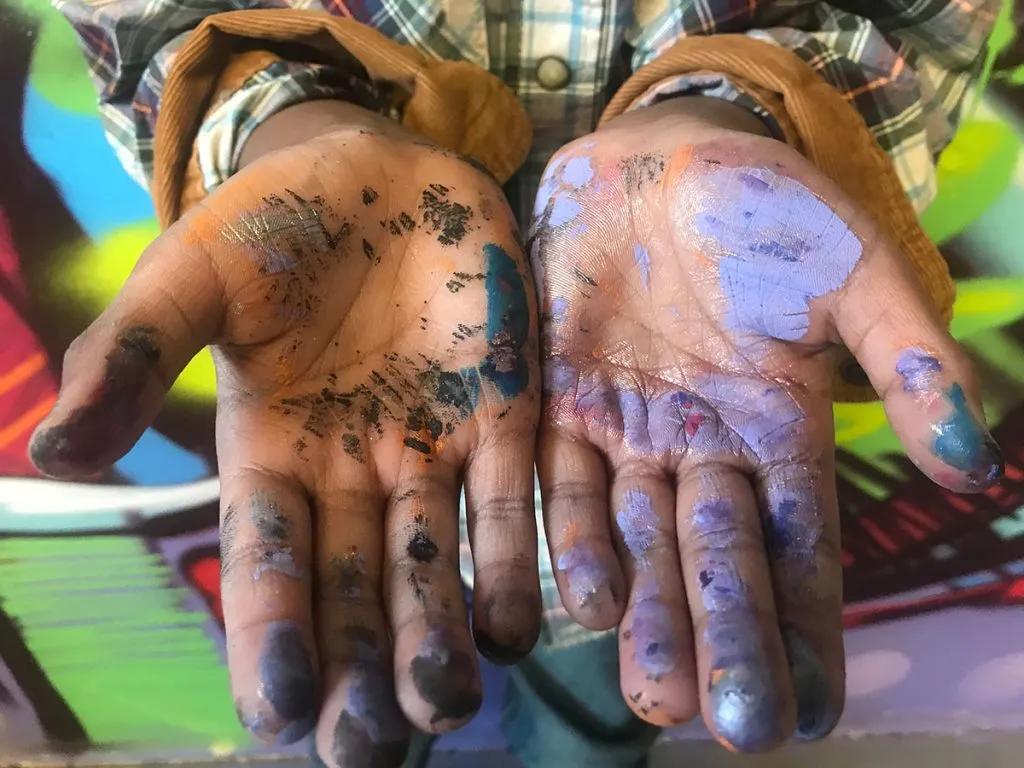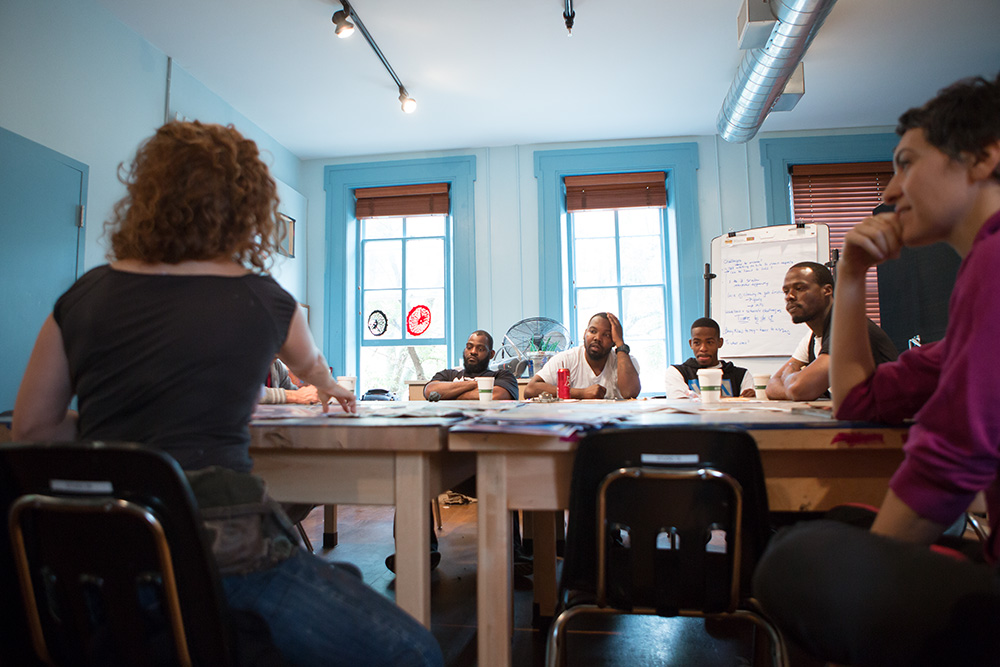Public Health and Public Art (Part 2)

Porch Light Program Director Laure Biron and Storiez founder Meagan Corrado both work at the intersection of art and mental health, with the goal of creating trauma-informed communities. But what does that mean? And how does it work? We brought these two together to talk about this important, meaningful practice in a thoughtful, two-part conversation.
When it comes to social stigmas about mental health, sometimes feelings of embarrassment and fear can keep people from seeking care. Does working with art help people feel more comfortable talking about mental health?
Meagan: Absolutely. Kids and teenagers, when they hear that they have a therapist, they’re just like, “Ugh.” It’s an instinctual barrier, because they’ve heard things about therapists before, and it feels too formal, too clinical, too much like, “You went through intensive training just to know how to talk to me.” It feels awkward and forced. That’s part of what informed the creation of Storiez, because a lot of the interventions out there are very off-putting for youth. To even introduce them to the interventions—just the names alone sound scary. It sounds like something that would be done in a laboratory, not something that feels approachable and relatable. It’s why my materials are very colorful and full of photographs. The goal is that we don’t see the healing process as something that has to be so scary—because historically, it has been scary. It looks intimidating. It looks unapproachable. It looks like something that I wouldn’t want to be involved in if I was a youth.
Laure: It’s something that is done to you, rather than collaboratively with you.
Meagan: Yes, and the arts always make things more approachable. It gives people power over their own experiences, and encourages them to personalize their experience of therapy, to make meaning in their own way.

Laure: Do you think also that there’s something powerful for those kids in having an output? Typically, therapy has no output. You just sit with a client and talk and talk, and there’s no there there.
Meagan: Absolutely—we talk about a holding environment, or a safe space, and if art can be that space for kids, they can go back to that project and know that it contains their thoughts. When they make a collage, they can infuse it with their experiences, and it’s something tangible that they can look at. It’s not something in their mind, or something behind closed doors.
Laure: We also find that in the mural-making process, it builds a sense of self-efficacy to say, “I made that.” It’s really effective in ways that other therapeutic interventions try to get at, but they don’t have an output, so there’s no artifact left over from the process. We work often with folks who are either in recovery or who are dealing with addiction in some way, and I think it’s really powerful for those folks to be able to point at something and say, “My imprint is on that.” It’s symbolic of a process that they’ve been going through.
Meagan: Within the context of trauma survivors, whether they’re youth or whether they’re adults struggling with addiction, they don’t have something where they can say, “Look at what I created.” Even if it’s ugly, even if it’s messy, even if they hate it, even if they want to crumple it up, even if it’s beautiful and they’re proud of it—they don’t have opportunities to say, “I created this.” That kind of opportunity isn’t embedded in our society. It’s empowering to be able to say it.

Laure: Yeah, definitely. A lot of folks want us to take pictures of them working on whatever project they’re doing in class, and often if you ask what they’re going to do with those photos, they’ll say that they’re sending the photos to their families. They want to show their families that they can do something constructive with their lives. So I think it’s really powerful for people to work on something that will have an end product, that they can either just have for themselves privately or that they can show to others.
Meagan: The other part of it, too, is that trauma survivors’ lives can be so filled with destruction. Destruction of relationships, destruction of the self, destruction of their thoughts, their view of the future. There isn’t room for creativity. And when you create that space to make something, it opens up another world—everything doesn’t have to be destruction.
How did you start working at the intersection of art and mental health?
Meagan: When I was a kid, I did creative writing all the time, and in 2012, I started doing mosaic. I finished my dissertation work in 2016, so I had been doing mosaic work for a few years. It was a parallel process of exploring, creating, and healing myself, and then also learning all the theory, all the clinical interventions. I felt like something was missing from the clinical side—this thing that’s all around us, the creative spirit—it’s not here. So how could I infuse it into the process for the people that I help?

Laure: I ended up in Philadelphia back in 2007, to start my MFA at PAFA, and I started working through my own stuff. I started reading a lot of psychoanalytic theory that was informing my artwork. I was also working at Mural Arts in the Art Education department with the program that they called ArtWorks—with the same kind of youth who are in our current Restorative Practices Youth program—and I felt totally ill-equipped for working in that classroom. At the same time, I was equipped with all these artistic skills, and I was starting to see the kind of change you would see in the clinical setting, but it was in the kids that I was working with. And I thought, “Oh, that’s the thing I want to do.” So as soon as I finished my MFA program, I enrolled at Bryn Mawr to do my social work program, in 2009. I was like, “Okay, I need the other half of my education.” And then the Porch Light position opened up at the right moment, which allowed me to lean into that work. I wasn’t sure until then how to really mesh the two, but it came out of my own artistic and teaching practices. I realized that these things were all connected, that they’re all the same.
Can you talk a little bit about the focus on trauma in your work?
Laure: In my experience, it’s impossible to work in any field that in any way touches on mental health without having a trauma component. All of us have experienced trauma in all different kinds of ways, and to label it as one or the other kind of misses the point. Operating from a trauma-aware place in whatever community we’re in—taking it a step farther, outside of mental health, talking about community work—that’s when we’re best servicing the folks that we’re working with.
Meagan: I’ve never not worked in a traumatized system, or worked with youth that were not in some way impacted by trauma. Even the youth that you would initially think were not, were. Trauma impacts us on so many levels. A lot of times we think about it as interpersonal violence, but so many systemic forms of trauma impact who were are and how we progress as individuals and as communities. If you can help someone manage their trauma symptoms, then you can help them manage their depression, their anxiety, their mood swings. The root of a whole lot of mental illness is trauma. It has different masks depending on the context, the person, the community, but when you take the mask off, it’s trauma.

Laure: Instead of labeling who has experienced trauma and who hasn’t, approaching community-based work from the perspective of being trauma-aware is good for everybody. I think we’ll have a “trickle-out” effect by helping folks approach their own neighborhoods, their own lives and families, in a way that’s trauma-informed.
Meagan: In the work that we both do, it’s about helping people be creative, and it’s about helping people find safety. It’s about building connection, repairing things that have been broken. And there’s something universal about that, that extends even if you don’t identify as a trauma survivor. These are all things that we need in order to develop as healthy individuals.
Laure: And it helps us be healthy support systems for the other people in our lives—like how they tell you to put your oxygen mask on before you help somebody else. It’s the same concept. When you feel safe, you’re better situated to create safe space for others. It just makes for a better, healthier community.
What is it about creativity that applies to mental health? Why use art as a vehicle for wellness?
Laure: Why do we have to live in these spaces of imagination to heal from trauma? The first part is getting buy-in. We live in a city that’s busy cutting art and music classes, where kids are not getting enough attention around creative writing. Anywhere that we can infuse the spirit of creativity and imagination, you’ll also find it starts to create a community that has the ability to be trauma-aware.
Meagan: What is it like to wake up in the morning and have no imagination, to have no color? To have no art, to have nothing to look forward to, to not imagine a different future for yourself, a different path for your life? If we don’t have that, then what are we here for? Creativity gives us purpose, drive, the strength to keep going even when we’ve been through challenges. Imagination helps us get back up again every time.
Laure: That gets back to the Mural Arts mission—I think about how our collection of public art is meant to be everywhere, and it’s meant to inspire that kind of creativity and imagination for everyone. It’s not just behind museum walls.
Meagan: Programs like ours are also saying that creativity is in you—it’s on the walls around you, it’s in the programs that you go to, and there’s imagination inside of you that, if you can tap into it, you can survive a whole lot more challenges.
Laure: And it’s not only for artists. Everyone has that creative capacity within them. It’s just having an opportunity and a belief in self to unlock that. What both of us do provides a space for that. I’m grateful for it, as a clinician and as an artist and as a human being.
Porch Light is a joint collaboration between Mural Arts Philadelphia and the City of Philadelphia’s Department of Behavioral Health and Intellectual disAbility Services.